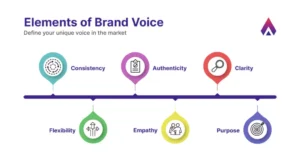It’s more crucial than ever to find your brand’s unique sound. Your brand voice is the personality of your business. It’s how you communicate with your audience, and it’s crucial for building a strong brand identity. A well-defined brand voice helps you connect with your customers on a deeper level, building trust and loyalty.
What is brand voice and why it matters?

Brand voice is the distinct personality and tone that comes through in a company’s communications, encompassing everything from marketing materials and social media posts to customer service interactions and website content. It is an integral part of your brand identity, reflecting your values, mission, and how you wish to be perceived by your audience. Just like people have unique voices characterized by their choice of words, tone, and manner of speaking, brands too must adopt a consistent voice that resonates with their target audience.
Understanding brand voice is crucial because it shapes how your audience perceives your business. A well-defined brand voice fosters a deeper connection with customers, making your messaging more relatable and engaging. For instance, a playful and casual tone might work wonders for a children’s toy company, whereas a professional and authoritative voice would be more appropriate for a legal firm. Consistency in your brand voice reinforces your identity and helps build trust; customers are more likely to engage with a brand they feel understands them and their needs.
Moreover, a strong brand voice differentiates you from competitors. In a saturated market, your unique voice can be the deciding factor that draws customers to choose your products or services over others. It humanizes your brand, turning it from a faceless entity into a relatable character that consumers can connect with. As you work on defining and honing your brand voice, remember that it should evolve alongside your business, adapting to changing times while remaining true to the core values that define who you are.
Identifying your brand values and personality

Identifying your brand values and personality is a crucial step in shaping a distinctive brand voice that resonates with your audience. Begin by reflecting on what your brand stands for: what core principles drive your business? These values could range from sustainability and innovation to community engagement and quality craftsmanship. Articulating these values not only helps define your brand’s identity but also serves as a foundation for all your communication.
Next, consider your brand’s personality. Is it playful and adventurous, or sophisticated and professional? Personality traits can be categorized into various archetypes such as the Hero, the Caregiver, or the Rebel. Each archetype embodies certain traits that can help guide the tone and style of your messaging. For example, a brand with a Hero personality might adopt a bold and empowering tone, while a Caregiver brand may lean towards nurturing and supportive language.
To fine-tune your brand voice, gather insights from your target audience. Conduct surveys or engage with customers on social media to understand how they perceive your brand and what values resonate with them. This will not only help you refine your voice but also foster stronger connections with your audience. Lastly, document your brand values and personality traits in a style guide. This guide will serve as a reference point for anyone involved in creating content for your brand, ensuring consistency across all platforms.
How to create a brand voice?
Creating a brand voice is an essential step in establishing a strong identity for your business and connecting with your target audience. Your brand voice represents the personality and tone of your brand, which can influence how consumers perceive and engage with your products or services. To begin, start by defining the core values and mission of your brand. Ask yourself what makes your business unique and what emotions you want to evoke in your audience.
Next, consider your target demographic. Understanding who your audience is will help you determine the language, tone, and style that resonate with them. Are they young and trendy or mature and sophisticated? Your brand voice should reflect the preferences of your target market, making it relatable and authentic.
Once you have a clear understanding of your brand’s values and your audience, it’s time to establish guidelines that outline your brand voice. These guidelines should cover aspects such as formality, vocabulary, and sentence structure. For instance, will your brand maintain a casual, conversational tone, or will it adopt a more formal and professional approach? Creating sample phrases or taglines can also help illustrate your brand voice in action.
Finally, consistency is key. Whether you’re crafting social media posts, writing blog articles, or designing marketing materials, ensure that your chosen brand voice is maintained across all platforms. This will help build recognition and trust with your audience. As you create your brand voice, remember that it can evolve over time. Stay open to feedback and be willing to adapt as your business grows or as trends shift. Ultimately, your brand voice is a reflection of who you are and what you stand for, so embrace it and let it guide your communication efforts.
Examples of brand voices
When it comes to branding, your brand voice is the distinct personality that comes through in your communications, influencing how your audience perceives your brand. Understanding different examples of brand voices can provide invaluable insights as you embark on your journey to cultivate your own. Here are a few notable examples that illustrate the diverse ways brands can express themselves:
Technology and telecommunications
- Safaricom (Kenya): Known for its youthful and energetic brand voice, Safaricom often uses colloquial language and humor to connect with its predominantly young customer base.
- MTN (South Africa): With a focus on inclusivity and empowerment, MTN adopts a more formal and authoritative tone while still maintaining a friendly approach.
- Airtel Africa: A youthful and energetic brand voice, often using colloquial language and relatable scenarios to connect with its target audience.
- Vodacom: A balance of professionalism and approachability, emphasizing reliability and customer satisfaction.
Fast-moving consumer goods (FMCG)
- Coca-Cola Africa: Embracing a universal language of happiness and togetherness, Coca-Cola’s brand voice is optimistic, inclusive, and celebratory.
- Pampers Africa: A nurturing and caring tone, emphasizing the importance of baby care and motherhood.
Banking and financial services
- Standard bank (Africa): Projects a professional, reliable, and trustworthy image, often using formal language and emphasizing financial expertise.
- KCB (Kenya): A more conversational and approachable tone, focusing on customer-centric solutions and financial empowerment.
Fashion and retail
- Mr Price (South Africa): A fun and affordable brand voice, targeting a young and trendy demographic.
- Zara: A sophisticated and aspirational tone, positioning the brand as a global fashion leader.
Maintaining brand consistency
Maintaining brand consistency is crucial for establishing a strong and recognizable brand voice that resonates with your audience. Consistency is not just about visual elements, such as logos and color schemes; it extends to the tone, language, and overall messaging that you use across all platforms. When your audience encounters your brand, whether on social media, your website, or in marketing materials, they should immediately feel the same sense of familiarity and connection.
To achieve this, start by developing a comprehensive style guide that outlines your brand’s voice and tone. This guide should include key elements such as preferred vocabulary, sentence structure, and guidelines for communicating with your audience. Are you aiming for a professional and authoritative tone, or a more casual and friendly approach? Clarifying these aspects will help ensure everyone on your team is aligned in their communication efforts.
Moreover, regularly audit your existing content to identify any inconsistencies. Look for variations in tone, messaging, and even style that may have crept in over time. By ensuring that all your content reflects the same voice, you create a cohesive experience for your audience, making your brand more relatable and trustworthy.
Lastly, consider the importance of feedback. Engage with your audience to gauge their perception of your brand voice. Are they responding positively? Is your messaging resonating with them? Use this valuable insight to refine your approach while staying true to your core identity.
Key considerations when developing a brand voice for African markets:
- Cultural nuances: Understand the specific cultural contexts and nuances of different African markets.
- Language and dialects: Adapt your messaging to suit the local language and dialects.
- Inclusivity: Ensure your brand voice is inclusive and resonates with diverse audiences.
- Authenticity: Be genuine and authentic in your communication.
- Local relevance: Connect with your audience by using local references and insights.
In conclusion, discovering and cultivating your brand voice is an essential journey that can significantly impact your connection with your audience. It’s not merely about choosing the right words; it’s about encapsulating your brand’s identity, values, and mission in a way that resonates deeply with your target market. Remember that your brand voice should evolve as your business grows, adapting to changes in your audience’s preferences and the broader market landscape. Engage with your customers, seek feedback, and continuously refine your voice to ensure it remains authentic and relevant. A well-defined brand voice will not only enhance your marketing efforts but also foster loyalty among your customers, turning them into passionate advocates for your brand. So take the time to explore, experiment, and ultimately embrace your unique sound. The right voice can transform your brand from simply a product or service into a memorable experience that captivates and inspires.

